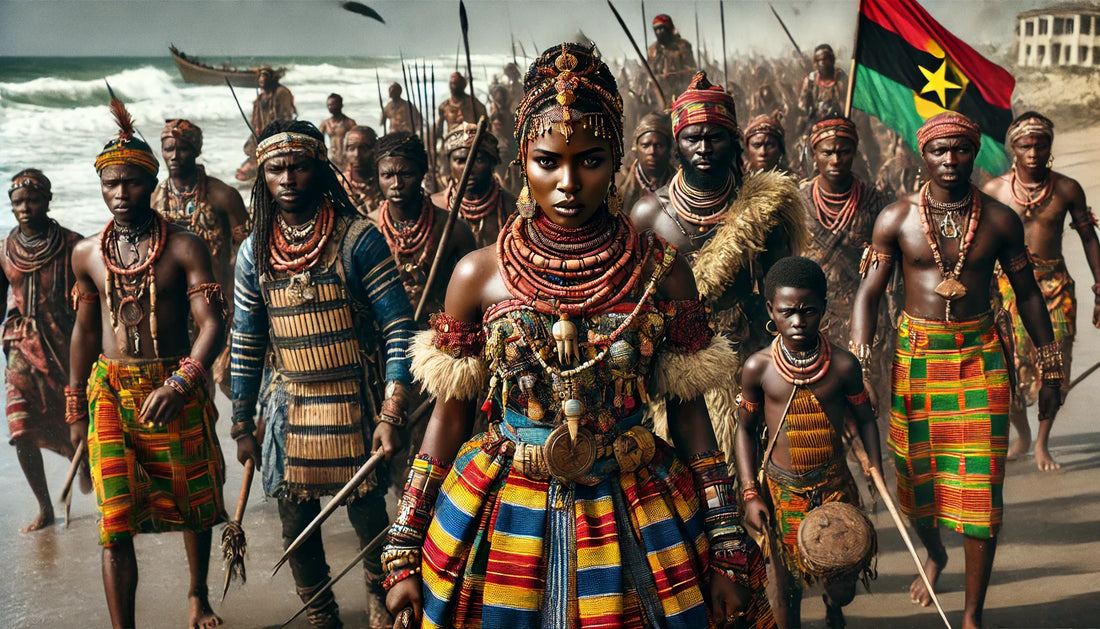
The Revolt of the Bay of Benin: The Uprising of the Children of the Land
Share Label
Chapter 1: The Emergence of the Guardians of the Bay
Once upon a time, in the mighty Kingdom of Dahomey, a proud and courageous people lived in harmony with the sea and the land. It was a kingdom where the beauty of women and the bravery of men blended with ancestral wisdom. The shadow of European colonizers had not yet struck their soil, yet invisible forces were conspiring in the corridors of the great capitals of the time, ready to break this unity.
By the shores of the Bay of Benin, where the waves crashed against the rocks and seafaring birds flew freely, the people prepared to face an uncertain destiny. It was a crucial moment in the history of Dahomey, an ancient and impetuous kingdom, whose glory had been shaped by its powerful kings and invincible warriors. But an event was about to shake history and mark the resistance of the Dahomean people at a time when colonization loomed as a menacing shadow over their existence.
Chapter 2: The Uprising
On the morning of the uprising, the Bay of Benin was calm, but the air was thick with tension. Rumors spread among the people: the European ships, bearers of misfortune, were approaching the coast. Yemoja, Nia, and the other leaders of the resistance had gathered the population, offering them a final counsel of peace, but also a call to rebellion.
Under the heat of the day, the warriors of the Bay, armed with spears and hand-carved shields, set off, their war cry echoing through the hills and trees. The people rose, ready to defend their land. The women of the Bay, masters of strategy, also joined the fighters, carrying bows and arrows they had forged themselves, ready to repel the invader.
The Europeans, who had underestimated the resistance of the Dahomean people, were caught off guard. Their fortress on the shores of the bay, usually impregnable, was now facing a wave of courage and determination. The battle raged, and the Bay of Benin, once silent, resonated with the cries of war and breaths of hope.
Chapter 3: The Victory of the Children of the Land
Although the colonial forces deployed strategies of terror and coercion, the bravery of the people of the Bay of Benin did not falter. In the blink of an eye, Yemoja's warriors surrounded the European soldiers, forcing them to retreat into the depths of the ocean. The victory of the Bay of Benin marked a historic turning point: it was not just a military victory, but a symbolic message of resistance against oppression and injustice.
The Bay of Benin was now free, and Yemoja was celebrated as the Queen of the Waves, the protector of the children of the land. The European slave traders, angered by their defeat, returned a few months later, but the spirit of revolt still lived in the hearts of the people. The people would never be crushed again. The Bay of Benin had become a symbol of the fight against injustice.
Chapter 4: The Legacy
Years later, when the great colonial powers had invaded other regions of the continent, the memory of the revolt of the Bay of Benin persisted. Yemoja and the Warriors of the Bay became legends, passed down from generation to generation. The children of the Bay, proud of their ancestors, continued to defend their heritage, the values of unity and resistance, and the freedom of their land.
Their songs resonated through the ages, telling the story of the great revolt against oppression, and the victory of the children of the land.









